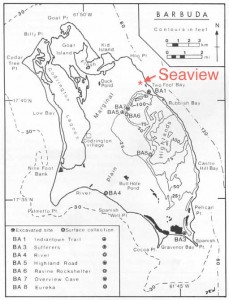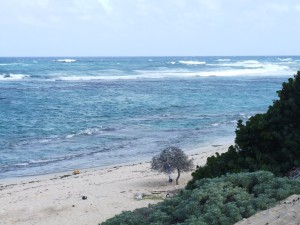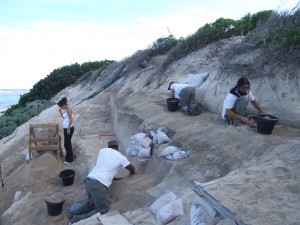This January will mark the fourth consecutive season of the Barbuda archaeology field school, organized by Prof. Sophia Perdikaris from Brooklyn College. A group of ten undergraduate students from across the CUNY system will participate in three weeks of excavation at the coastal site of Seaview, as well as attend lectures and conduct group projects of their choosing. In conjunction with the excavation I will be shooting video footage of all aspects of the excavation process. These videos will be edited into a series of 5-7 minute clips that introduce the viewer to the process of excavating a site. This project is a continuation of what began in Iceland last summer, where I experimented with some video footage of the excavations. Once completed, the videos will be made available to the public via the North Atlantic Biocultural Organization website, www.nabohome.org. Further, each student will be given a small Flip camera and required to shoot and edit first-person narratives of their field experience. These narrative videos will hopefully provide some insight into the success of the archaeology field school as a tool to allow students an active hands-on learning experience. My hope for this blog is that it will provide a commentary on the integration of active learning concepts, aspects of social media, and video to disseminate information about archaeological fieldwork and enrich the learning experience of undergraduate archaeology students.
Not only is there educational value in these videos, but also the valuable experience gained by the students actually participating in the field school. In terms of finding ways to effectively engage students in the learning process, participation in an excavation project is ideal. Archaeology field schools draw naturally from ideas put forth by Dewey in Experience and Education (1938), regarding active learning experiences. Involving the students in the construction of knowledge through various forms of academic investigation, including fieldwork, will provide a more grounded frame of reference for the students. Getting them involved on this level also serves to collapse the traditional distinction between student and teacher, as we work as a team in the process of excavation. All the tasks are of equal importance and everyone is involved in every step. This notion of collapsing traditional distinctions is discussed by McCarthy and Wright, in Technology as Experience (2004), at length in their treatment of Bakhtin’s creative understanding. Here the authors are developing ideas of how meaning gets formed by a process of “bringing together different perspectives and, in this creative bringing together, forging understanding”. The broad range of cultures represented in the CUNY student body should make manifest a diversity of perspectives about the work being carried out. The second part of the video project, arming the students themselves with video cameras should help bring these various perspectives to the surface. Allowing the students to express themselves through video and create something original that pertains to their experience should not only add to the learning process as they experience it, but also provide valuable feedback on our end, allowing the teachers/supervisors to see what the students find interesting and valuable. Engendering this type of educational experience within the context of archaeological and environmental research and education is very exciting to say the least.
Getting the students involved in the excavation has two more relevant implications. First, it reintroduces material culture into education (Huber and Hutchings 2005). For too long the mind has been privileged over the body, and thinking over doing (Dewey 1938). Giving the students a truly hands on experience, where they are actively touching, feeling, digging, and discovering, will only serve to enhance the breadth of learning. Second, and tying back into creative understanding from above, is Dourish’s idea of participatory design (Dourish 2001). Instead of being applied to computer development we can also make use of the concept in the broader sense of pedagogy. I learned this first hand last summer working in Greenland. Having brought a group of middle school kids to the site to participate for the day, thinking we were done excavating and no damage could possibly be done to the site, the kids led us to the realization that we had not actually finished removing one final cultural layer. It was a slightly humbling moment but also speaks to this notion of student’s involvement being potentially useful for the advancement of research in general. Why not let them play a role in the development of research design? Hopefully, as we move forward with similar projects involving student participants, their role will continue to be valued as an integral part of the educational process.
The final part of this project involves some aspects of social media, in the form of this blog, which will allow me to document and comment on the project as it unfolds. This blog will not only serve as my personal outlet but also give voice to the students involved. In this way, we can see how Benkler’s networked information economy is actively allowing the students to share their unique perspective to a limitless audience (Benkler 2007). This project will seek to use various technological tools; video cameras, laptops, and the Internet, to democratize the learning experience for a group of undergraduate students and at the same time allow them an outlet to share this experience with others. Before these tools were available, the typical archaeology field school experience more or less occurred in a vacuum. It would have been relatively difficult to share the experience with classmates, friends, family members, etc. The blogs placement on the Internet will not only allow the public to view it, but also comment. So the blog itself will potentially serve as a vehicle for communication between the students and I, in the field, and  those interested in the experience from a distance. The new paradigm, as Benkler presents it, gives agency to everyone and a platform from which to act. The combination of Flip cameras and the Internet will serve as tools for the students to create and participate in the networked information economy.
those interested in the experience from a distance. The new paradigm, as Benkler presents it, gives agency to everyone and a platform from which to act. The combination of Flip cameras and the Internet will serve as tools for the students to create and participate in the networked information economy.
I will be heading to Barbuda on the 28th and the field school will officially begin on January 4th. Internet connection permitting, expect updates here once the project gets underway. Just a side note: it is 82o F in Barbuda today.
[cetsEmbedGmap src=http://maps.google.com/maps?f=q&source=s_q&hl=en&geocode=&q=Barbuda,+Antigua+and+Barbuda&sll=14.51978,-74.970703&sspn=45.306954,62.050781&g=Caribbean+sea&ie=UTF8&hq=&hnear=Barbuda&ll=15.008464,-65.588379&spn=11.569529,15.512695&z=6 width=500 height=425 marginwidth=0 marginheight=0 frameborder=0 scrolling=no]
References
Benkler, Yochai. 2007. The Wealth of Networks: How Social Production Transforms Markets and Freedom. Yale University Press.
Dewey, John. 1938. Experience and Education. New York: Touchstone.
Dourish, Paul. 2001. Where the Action Is: The Foundations of Embodied Interaction. Massachusetts Institute of Technology: MIT Press.
Huber, Mary T., and Pat Hutchings. 2005. The Advancement of Learning: Building the Teaching Commons. San Francisco: Jossey-Bass.
McCarthy, John, and Peter Wright. 2004. Technology as Experience. MIT Press.




Sounds wonderful, Aaron (especially when you noted the weather in Barbuda today!) Looking forward to reading your posts this upcoming semester and best with your project!!
[…] Iceland and the digging that produced some pipes and dice. This time Aaron is off to Seaview and taking us with him again! This project sounds amazing and I can’t wait to see what the students put together for […]